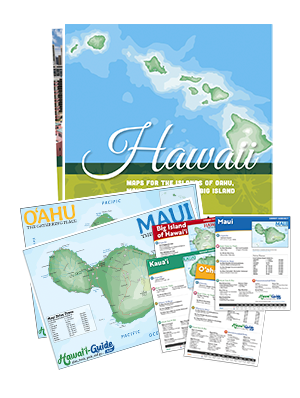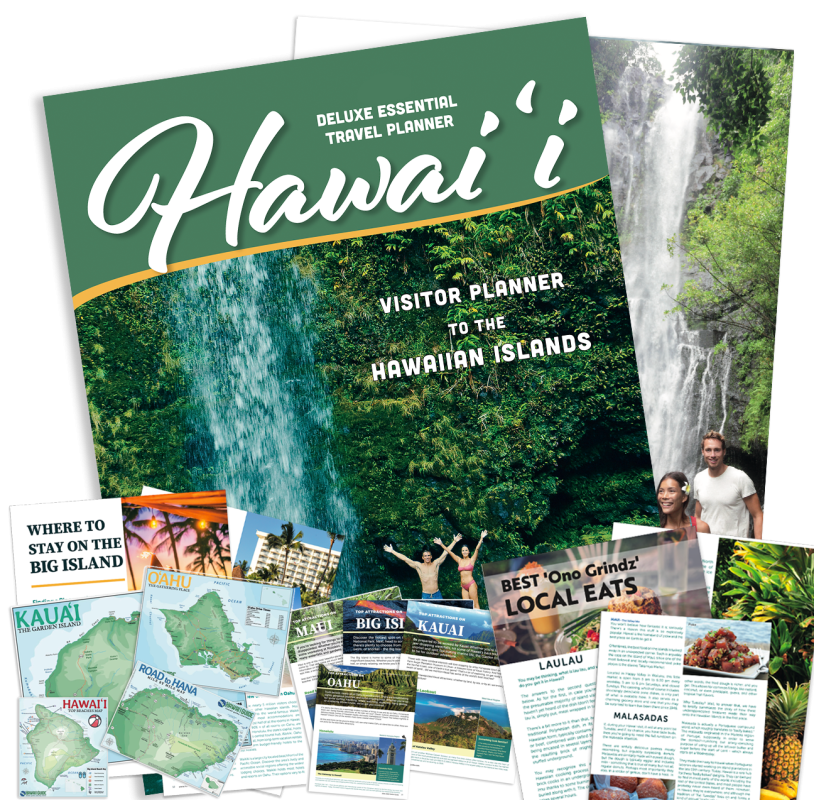Traveling to Hawaii's gorgeous islands is a dream for many travelers due to its unique culture and lush, diverse natural splendor. However, as one of the thousands of tourists that visit Hawaii annually, it can be hard to set yourself apart from the crowd and look more like a native of the land than a visitor. Sadly, some hold significant stigmas against tourists, and scammers and pickpockets often target them. Luckily, there are some simple ways you can blend in to avoid such unpleasantries.
Read on to learn the best ways to shed your tourist persona and travel the islands of Hawaii in peace with ease. These tips can range from altering your appearance to incorporating new vocabulary and researching the region.
— article continued below —
2024 Hawaii Visitor Guides
Visiting Hawaii soon? Be sure to grab a copy of one of our updated Hawaii Visitor Guides.
~ Trusted by Millions of Hawaii Visitors Annually ~
Learn the Lay of the Land
One of the easiest ways to pick a tourist out of a crowd in Hawaii is when they are lost. Before you set foot on a boat or plane to the islands, make sure you have a brief itinerary planned out for your trip and you've researched how to get to each location.
Hawaii can be difficult to traverse and navigate due to its geographic layout, with various valleys, shorelines, and volcanic mountain regions spanning the islands. You'll want to know the best and easiest way to get to each location. Sometimes this will involve public transportation over renting a vehicle, which is often a tourists' first choice.
Incorporate Hawaiian Vocabulary
This point can't be overstated enough. Apart from looking lost, another tell-tale sign that someone is a tourist is when they completely botch the pronunciation for common Hawaiian words. This might be local foods, greetings, street names, etc.
Locals can also tell when someone is a tourist just by talking to them and noticing a lack of traditional Hawaiian phrases or slang in their speech.
In order to look more like a local and less like a tourist, take some time before you arrive in Hawaii to learn some of the region's most common phrases and slang that you are likely to hear.
You don't need to completely learn the Hawaiian language since most inhabitants speak predominantly English with a sprinkling of Hawaiian phrases in their everyday speech. But incorporating at least a few common words and phrases in your vocabulary or at least being familiar enough with the language to pronounce traditional foods and locations properly will make all the difference.
Here are a series of common Hawaiian phrases, foods, and slang, along with necessary translations to get you started.
Common Hawaiian phrases
- Aloha: Directly translates to "Hello" and "Goodbye" interchangeably but has a deep meaning for Hawaiian people connoting love and kindness.
- Mahalo: Thank you
- Kama'aina: Direct translation is "child of the land" and refers to native Hawaiians or the locals.
- Ohana: Family. Another Hawaiian word with a very deep meaning weighted in love and respect for blood-relatives or those close enough to earn the title.
Traditional Hawaiian foods
- Saimin
- Poke
- Luau Stew
- Poi
- Laulau
- Kalua pig
- Lomi Salmon
- Spam Musubi
- Shave Ice
- Loco Moco
- Haupia Pie
- Manapua
- Huli Huli Chicken
- Lau Lau
Common Hawaiian slang
- Ainokea: "I don't care."
- Brok da mout: Describes food that was almost unbearably delicious.
- Choke: Used to describe large quantities of something.
- Grind: Describes good food.
- Hana hou: Again!
- Shaka: A common hand gesture used for greetings or departures. Create a fist and hold your thumb and pinky outwards.
- Shoots: "Okay"
- Haole: Used to describe a non-native (like a tourist). If you hear this, they're on to you…
Do as the Locals Do
If you want to look like a local, then "when in Rome," well, you know what we mean. A great way to not look like the typical tourist is to steer clear of all the touristy hotspots and locations that locals aren't likely to visit.
Of course, you don't want to do this to such an extent that it ruins your trip. You should still visit the attractions and natural splendors that make Hawaii unique and unforgettable, like Hawaii Volcanoes National Park and its many beaches.
This tip is really referring to typical eateries, bars, and other hangouts that locals love to visit, both for the atmosphere and services and the opportunity to avoid overwhelming tourist crowds.
You can try looking some of these locations up online before your trip, but if you can't seem to find much in the region you'll be staying in, you might just have to expose yourself as a tourist briefly to ask a local where they would go.
You can also just use your powers of observation when traveling to pick out locations that are clearly high-traffic areas for tourists, and therefore, likely to be teeming with them. If a restaurant or bar seems overly "Hawaiian," it's probably trying to hyperbolize the culture to bring in tourists and isn't the most authentic location for you to visit.
Dress for Success
Looking at the part is just as important as acting the part. If you don't want to look like a Hawaiian tourist, pack your wardrobe with the most Hawaiian articles of clothing you have. You can even acquire a shirt or two for the occasion.
Not only will this help you fit in, but you are also guaranteed to be dressed appropriately for the region if you're wearing the same general articles of clothing as people that live in Hawaiian weather every day.
Although some of them might seem a bit stereotypical, these are the common pieces of clothing worn by native Hawaiians regularly.
- Hawaiian/Aloha shirts
- Board shorts
- Loose-fitting pants or shorts
- Comfortable shoes like sandals or flip flops
- Colorful sundresses
- Muumuu dresses
- Tank tops
- Pa'u hula skirts
- Clothing is made with natural materials like cotton or silk to help with heat and humidity.
- Highly colorful floral patterns
If you don't own any of these pieces of attire or those you have aren't in traditional Hawaiian colors or patterns, there are several typical retail clothing stores, like Target and Walmart, that will offer what you need.
Let Go of Your "Mainland Mentality"
You've finally made it to Hawaii, the ultimate island paradise, and statistically, you've most likely arrived from somewhere else in the United States. This means you probably have a certain mentality regarding punctuality. Yeah, you can throw all those out the window now. When you're in Hawaii, you're subject to "Hawaiian time."
This concept sounds bizarre, but it is a very real thing. There are certainly hard-working individuals that live in Hawaii, but the region has an overarching "go with the flow" mentality. Therefore, punctuality isn't really a priority, and people tend to take their time and arrive when it suits them. This might mean that your tour starts five minutes late or 25 minutes late, depending on what that guide was doing, how they're feeling, and how the previous tour went.
For many tourists who don't have prior knowledge of this island ideology, this is a great source of anxiety and frustration.
Unfortunately, the worst thing you can do as a tourist is to get angry or fret over the situation. Especially on the roads. Driving in Hawaii isn't like driving in the suburbs. The island mentality of "Hawaiian time" means it's likely you'll come across a vehicle taking its sweet time and driving 10 miles under the speed limit. Rather than blasting your horn, you're better off sitting back and enjoying their bumper stickers.
It is best to realize that Hawaiians don't have the "go, go, go" mentality found in various other regions of the world and to just accept this and perhaps adapt it yourself during your stay. But be careful.
Since Hawaii is such a tourist and vacation hotspot, it is easy to get sucked into its laid-back lifestyle. However, Hawaiian time is still just a general mindset many people on the island have and not applicable to all elements of the region.
You shouldn't be surprised when things take longer than you'd expect, but adopting this mentality doesn't mean you should show up for your dinner reservation 15 minutes late or expect a 10 am bus to still be there by 10:10 am.
Although "Hawaiian time" is something you should expect if you want to blend in as a tourist, it isn't an acceptable excuse.

















